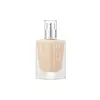What's inside
What's inside
 Key Ingredients
Key Ingredients

 Benefits
Benefits

 Concerns
Concerns

 Ingredients Side-by-side
Ingredients Side-by-side

Cyclohexasiloxane
EmollientWater
Skin ConditioningTitanium Dioxide
Cosmetic ColorantDimethicone
EmollientEthylhexyl Methoxycinnamate
UV AbsorberPhenyl Trimethicone
Skin ConditioningMethyl Trimethicone
Skin ConditioningAlcohol Denat.
AntimicrobialVinyl Dimethicone/Methicone Silsesquioxane Crosspolymer
Phytosteryl/Isostearyl/Cetyl/Stearyl/Behenyl Dimer Dilinoleate
Skin ConditioningNiacinamide
SmoothingCetyl PEG/PPG-10/1 Dimethicone
EmulsifyingSynthetic Fluorphlogopite
Disteardimonium Hectorite
StabilisingMagnesium Sulfate
Butylene Glycol
HumectantPentylene Glycol
Skin ConditioningPropanediol
SolventTriethoxycaprylylsilane
Trimethylsiloxysilicate
EmollientPolyglyceryl-4 Isostearate
EmulsifyingAluminum Hydroxide
EmollientSilica Dimethyl Silylate
EmollientGlyceryl Caprylate
EmollientCaprylyl Glycol
EmollientDisodium Stearoyl Glutamate
CleansingEthylhexylglycerin
Skin ConditioningAdenosine
Skin ConditioningXylitylglucoside
HumectantAnhydroxylitol
HumectantXylitol
HumectantTocopherol
AntioxidantGlucose
HumectantParfum
MaskingCI 77492
Cosmetic ColorantCI 77491
Cosmetic ColorantCI 77499
Cosmetic ColorantCyclohexasiloxane, Water, Titanium Dioxide, Dimethicone, Ethylhexyl Methoxycinnamate, Phenyl Trimethicone, Methyl Trimethicone, Alcohol Denat., Vinyl Dimethicone/Methicone Silsesquioxane Crosspolymer, Phytosteryl/Isostearyl/Cetyl/Stearyl/Behenyl Dimer Dilinoleate, Niacinamide, Cetyl PEG/PPG-10/1 Dimethicone, Synthetic Fluorphlogopite, Disteardimonium Hectorite, Magnesium Sulfate, Butylene Glycol, Pentylene Glycol, Propanediol, Triethoxycaprylylsilane, Trimethylsiloxysilicate, Polyglyceryl-4 Isostearate, Aluminum Hydroxide, Silica Dimethyl Silylate, Glyceryl Caprylate, Caprylyl Glycol, Disodium Stearoyl Glutamate, Ethylhexylglycerin, Adenosine, Xylitylglucoside, Anhydroxylitol, Xylitol, Tocopherol, Glucose, Parfum, CI 77492, CI 77491, CI 77499
Water
Skin ConditioningC9-12 Alkane
SolventSqualane
EmollientCoco-Caprylate/Caprate
EmollientPropanediol
SolventGlycerin
HumectantPentylene Glycol
Skin ConditioningSorbitan Isostearate
EmulsifyingPolyglyceryl-3 Polyricinoleate
EmulsifyingTribehenin
EmollientEthyl Oleate
EmollientButylene Glycol
HumectantDisteardimonium Hectorite
StabilisingEctoin
Skin ConditioningSilica
AbrasiveRosa Canina Fruit Extract
AstringentPlankton Extract
Skin ConditioningButyrospermum Parkii Butter Unsaponifiables
Skin ConditioningTocopherol
AntioxidantEthyl Stearate
EmollientEthyl Linoleate
EmollientEthyl Palmitate
EmollientEthylhexyl Polyhydroxystearate
EmollientLecithin
EmollientXanthan Gum
EmulsifyingSucrose
HumectantLysine
Skin ConditioningGlyceryl Caprylate/Caprate
EmollientSodium Lauroyl Glutamate
Magnesium Chloride
Aluminum Hydroxide
EmollientCI 77891
Cosmetic ColorantIron Oxides
Water, C9-12 Alkane, Squalane, Coco-Caprylate/Caprate, Propanediol, Glycerin, Pentylene Glycol, Sorbitan Isostearate, Polyglyceryl-3 Polyricinoleate, Tribehenin, Ethyl Oleate, Butylene Glycol, Disteardimonium Hectorite, Ectoin, Silica, Rosa Canina Fruit Extract, Plankton Extract, Butyrospermum Parkii Butter Unsaponifiables, Tocopherol, Ethyl Stearate, Ethyl Linoleate, Ethyl Palmitate, Ethylhexyl Polyhydroxystearate, Lecithin, Xanthan Gum, Sucrose, Lysine, Glyceryl Caprylate/Caprate, Sodium Lauroyl Glutamate, Magnesium Chloride, Aluminum Hydroxide, CI 77891, Iron Oxides
 Reviews
Reviews

Ingredients Explained
These ingredients are found in both products.
Ingredients higher up in an ingredient list are typically present in a larger amount.
Aluminum Hydroxide is a form of aluminum. It can be naturally found in nature as the mineral gibbsite. In cosmetics, Aluminum Hydroxide is used as a colorant, pH adjuster, and absorbent.
As a colorant, Aluminum Hydroxide may add opacity, or reduce the transparency. Aluminum hydroxide is contains both basic and acidic properties.
According to manufacturers, this ingredient is an emollient and humectant. This means it helps hydrate the skin.
In medicine, this ingredient is used to help relieve heartburn and help heal ulcers.
There is currently no credible scientific evidence linking aluminum hydroxide in cosmetics to increased cancer risk.
Major health organizations allow the use of aluminum hydroxide in personal care products and have not flagged it as a carcinogenic risk at typical usage levels.
Learn more about Aluminum HydroxideButylene Glycol (or BG) is used within cosmetic products for a few different reasons:
Overall, Butylene Glycol is a safe and well-rounded ingredient that works well with other ingredients.
Though this ingredient works well with most skin types, some people with sensitive skin may experience a reaction such as allergic rashes, closed comedones, or itchiness.
Learn more about Butylene GlycolDisteardimonium Hectorite comes from the clay mineral named hectorite. It is used to add thickness to a product.
It can also help stabilize a product by helping to disperse other ingredients.
Hectorite is a rare, white clay mineral.
Learn more about Disteardimonium HectoritePentylene glycol is typically used within a product to thicken it. It also adds a smooth, soft, and moisturizing feel to the product. It is naturally found in plants such as sugar beets.
The hydrophilic trait of Pentylene Glycol makes it a humectant. As a humectant, Pentylene Glycol helps draw moisture from the air to your skin. This can help keep your skin hydrated.
This property also makes Pentylene Glycol a great texture enhancer. It can also help thicken or stabilize a product.
Pentylene Glycol also acts as a mild preservative and helps to keep a product microbe-free.
Some people may experience mild eye and skin irritation from Pentylene Glycol. We always recommend speaking with a professional about using this ingredient in your routine.
Pentylene Glycol has a low molecular weight and is part of the 1,2-glycol family.
Learn more about Pentylene GlycolPropanediol is an all-star ingredient. It softens, hydrates, and smooths the skin.
It’s often used to:
Propanediol is not likely to cause sensitivity and considered safe to use. It is derived from corn or petroleum with a clear color and no scent.
Learn more about PropanediolTocopherol (also known as Vitamin E) is a common antioxidant used to help protect the skin from free-radicals and strengthen the skin barrier. It's also fat soluble - this means our skin is great at absorbing it.
Vitamin E also helps keep your natural skin lipids healthy. Your lipid skin barrier naturally consists of lipids, ceramides, and fatty acids. Vitamin E offers extra protection for your skin’s lipid barrier, keeping your skin healthy and nourished.
Another benefit is a bit of UV protection. Vitamin E helps reduce the damage caused by UVB rays. (It should not replace your sunscreen). Combining it with Vitamin C can decrease sunburned cells and hyperpigmentation after UV exposure.
You might have noticed Vitamin E + C often paired together. This is because it is great at stabilizing Vitamin C. Using the two together helps increase the effectiveness of both ingredients.
There are often claims that Vitamin E can reduce/prevent scarring, but these claims haven't been confirmed by scientific research.
Learn more about TocopherolWater. It's the most common cosmetic ingredient of all. You'll usually see it at the top of ingredient lists, meaning that it makes up the largest part of the product.
So why is it so popular? Water most often acts as a solvent - this means that it helps dissolve other ingredients into the formulation.
You'll also recognize water as that liquid we all need to stay alive. If you see this, drink a glass of water. Stay hydrated!
Learn more about Water